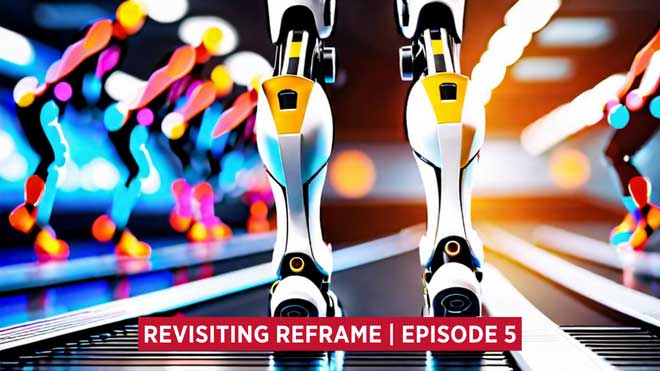Revisiting Reframe Episode 5: The Enigma of Elegance: Unraveling the Intricacies of Movement
In this episode of our podcast, we sit down with William Berg, professor of Kinesiology, to delve into the intricacies of human movement.

In this episode of our podcast, we sit down with William Berg, professor of Kinesiology, to delve into the intricacies of human movement.

This blog post and image were generated by Headliner AI.
Have you ever stopped to think about what goes into the simple act of reaching for a cup of coffee? Or the myriad of processes that occur when you walk, jump, or even stand still? It turns out the science of movement is a vast and largely uncharted expanse, brimming with mystery and complexity.
In this episode of our podcast, we sit down with William Berg, professor of Kinesiology, to delve into the intricacies of human movement. Berg opens our eyes to the fact that movement is not just a mundane part of our daily lives but is the primary way we interact with the world around us. From the subtle anticipatory postural adjustments we make without thinking to the grander scale of how our brain predicts and adapts to various situations, the conversation reveals a hidden world of sophistication behind our every action.
Berg explains that although we've made significant strides in understanding cognition and designing intelligent machines, our grasp on the dexterity and adaptability of human movement is still in its infancy. Robots might replicate specific tasks, but when it comes to the fluidity and versatility of a 5-year-old child, they fall short. This gap in understanding underscores the profound complexity of the human brain and the central nervous system, which orchestrates our movements in ways we are only beginning to comprehend.
The discussion also touches on the fascinating concept of anticipatory postural adjustments—automatic, unconscious muscle responses that stabilize us in preparation for movement. These adjustments, which we've only known about since 1969, are just one example of the brain's predictive powers and its ability to adapt based on the body's condition, like fatigue.
As the episode progresses, it becomes clear that the study of movement intersects with various disciplines, from neuroscience to engineering, and even touches on self-organizing systems observed in nature. Berg shares insights into passive dynamic walkers, simple mechanical systems that mimic human locomotion without any motors or brains, challenging our understanding of why we move the way we do.
By the end of the conversation, you'll have a newfound appreciation for the complexity of your own movements and a curiosity about potential advancements in learning, rehabilitation, and even the evolution of human movement in different gravitational environments.
501 E. High Street
Oxford, OH 45056
1601 University Blvd.
Hamilton, OH 45011
4200 N. University Blvd.
Middletown, OH 45042
7847 VOA Park Dr.
(Corner of VOA Park Dr. and Cox Rd.)
West Chester, OH 45069
Chateau de Differdange
1, Impasse du Chateau, L-4524 Differdange
Grand Duchy of Luxembourg
217-222 MacMillan Hall
501 E. Spring St.
Oxford, OH 45056, USA
Mosler Hall 316
1601 University Blvd.
Hamilton, OH 45011